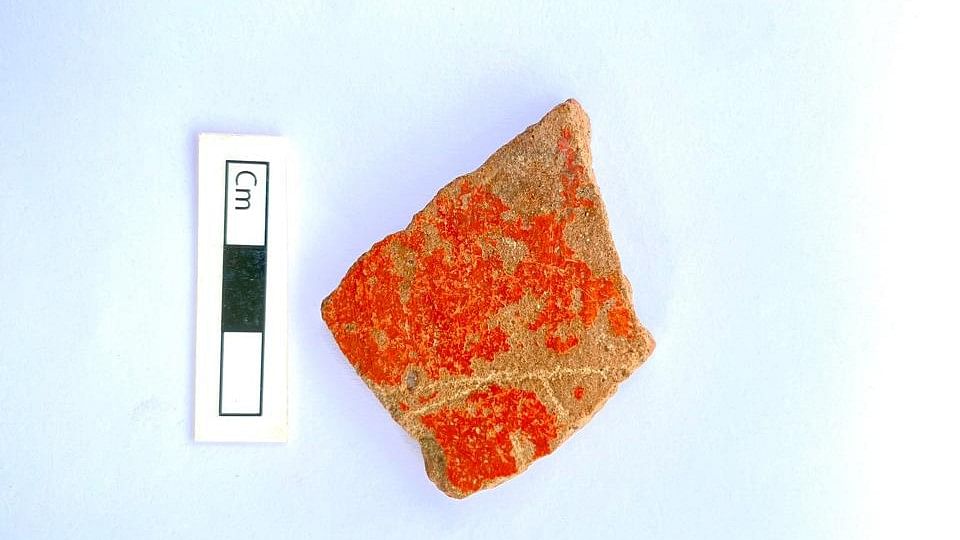
The potsherd unearthed in Tirunelveli district.
Credit: TNSDA
Chennai: Archaeologists have unearthed a potsherd with Tamil letter ‘Tha’ inscribed on it from Keeladi, a Sangam-era urban settlement site on the banks of River Vaigai in Madurai, in the first recovery of Tamili (Tamil-Brahmi) inscribed potsherd in the 10th season of digging which began on June 18.
The first week of excavation in Keeladi has also resulted in the recovery of over 50 antiquities, beads, spindle whorls, and hopscotch, besides heaps of potsherds. Keeladi, 12 km southeast of Madurai where excavations first began in 2014, bore enough evidence of an urban industrialised settlement, with carbon-dating of artefacts from the site establishing its age to be 2,600 years old.
With the Archaeological Survey of India (ASI) pulling out of the digging under controversial circumstances in 2017, the Madurai Bench of the Madras High Court asked the Tamil Nadu State Department of Archaeology (TNSDA) to take over the excavation from 2018. Over 20,000 artefacts have been unearthed from Keeladi in the past 10 years and the current season is also expected to throw surprises.
“The Tamili-inscribed potsherd with the word ‘Tha’ was unearthed from one of the trenches on Tuesday. It was found at a depth of 52 cm. This is the first Tamili-inscribed potsherd this season and we hope to stumble upon more such inscribed potsherds,” a senior official with the TNSDA told DH.
Last year, archaeologists had unearthed four potsherds with Tamil letters -- notable being the one with Puli (Tiger) written on it, from Thulukarpatti in Tirunelveli district. The recovery of Tamili-inscribed potsherds signifies that those who inhabited the sites were literate and spoke a language.
This week also marked the unearthing of a broken Neolithic hand axe and a terracotta female figurine being unearthed from Chennanur in Krishnagiri district and Vembakkottai in Virudhunagar district respectively.
The axe, which is 6 cm long and 4 cm wide, was found at a depth of 53 cm, while the dimension of the female figurine is 30.7 mm height and 25.6 mm width.
The finding of a Tamili-inscribed potsherd assumes significance in the wake of the TNSDA announcing that fresh scientific dates obtained through Accelerator Mass Spectrometry (AMS) dating of samples collected from archaeological sites have pushed the origin of Tamili (Tamil-Brahmi) script by hundred years to 7th Century BCE.
Of the 73 AMS dates obtained from Beta Analytic Laboratory, Florida, US after a detailed analyses into samples collected from excavation sites such as Kodumanal, Keeladi, Korkai, Alagankulam, Porunthal and Sivagalai, the earliest date arrived at is 685 BCE from Sivagalai in Thoothukudi district, sources in the TNSDA told DH.
“The calibrated date at Keeladi, an urban industrialised settlement found on the banks of River Vaigai near the ancient city of Madurai, is 679 BCE,” sources had told DH early this month.
The launch of excavations comes at a time the exercise has created a buzz in the past few years after they threw up surprises. Artefacts unearthed in Keeladi pushed the Sangam Era to 600 BCE from 300 BCE, rice husks found in a burial urn in Sivakalai was found to be 3,200 years old, and that Tamils were aware of iron technology in 2172 BCE, 4,200 years ago.
The carbon dating pushed the Sangam Era by three hundred years that it was thought to be. The Archeological Survey of India, which conducted the first two phases of excavation, also derived the period of the Sangam-era archaeological site to be between 8th century BCE to 3rd century CE.
These findings come amidst repeated assertions by Chief Minister M K Stalin that his government will take every step to scientifically prove that India’s history will have to be rewritten from the Tamil landscape, in the light of findings in Keeladi and Sivakalai.